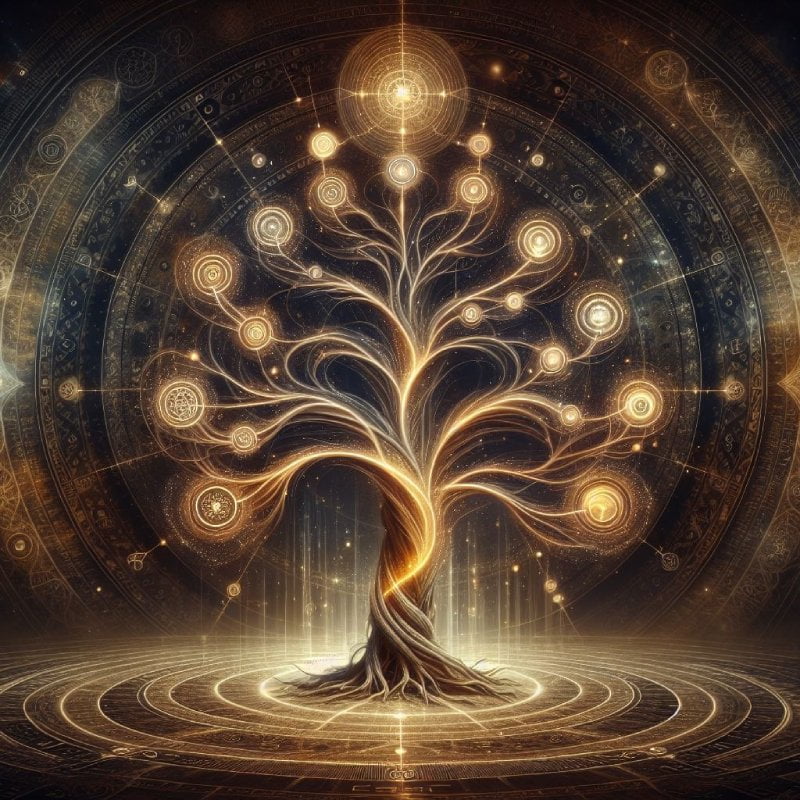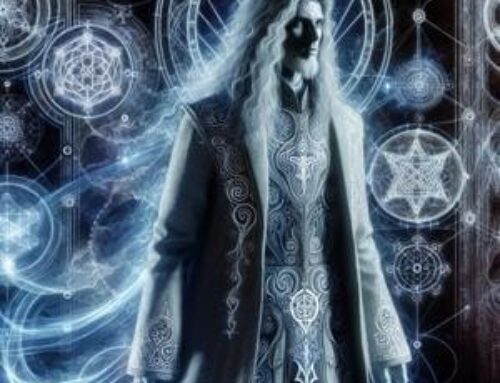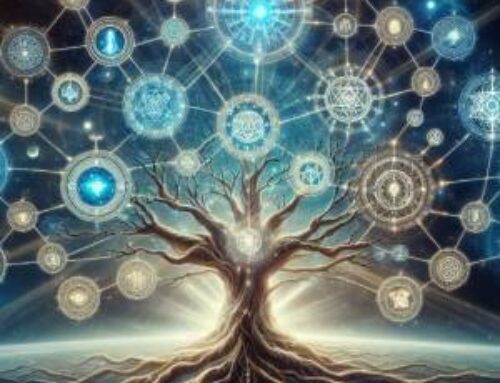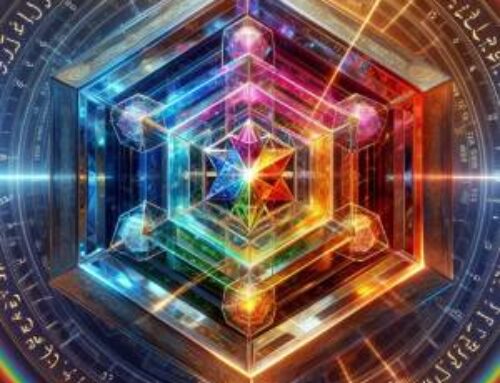Contents
- 1 Introduction to the Tree of Death Kabbalah
- 2 Foundational Concepts of Kabbalah and the Tree of Death
- 3 The Spheres of the Tree of Death: A Journey through the Qliphoth
- 4 Practical Applications of the Tree of Death in Modern Esoteric Practices
- 5 Conclusion
- 6 FAQ – The Tree of Death Kabbalah
- 6.1 1. What is the Tree of Death in Kabbalistic teachings?
- 6.2 2. How does the Tree of Death apply to modern esoteric practices?
- 6.3 3. Why is it important to explore both the Tree of Life and the Tree of Death?
- 6.4 4. How can one begin their journey with the Hermetic Academy, especially through the teachings of the Tree of Death?
- 6.5 5. What are the practical benefits of integrating the lessons of the Tree of Death into one’s spiritual practice?
- 7 References
Introduction to the Tree of Death Kabbalah
In the shadowed corridors of Kabbalistic mysticism, the Tree of Death stands as a stark yet profound counterpart to the luminous Tree of Life. Unlike its celebrated sibling, which maps the divine architecture of the universe, the Tree of Death delves into the realms of the Qliphoth, where the fragmented, the fallen, and the forsaken aspects of existence reside. This esoteric journey invites the audacious seeker to explore the inverse sephiroth, each representing a complex sphere of anti-light and misunderstood entities that govern the darker aspects of the spiritual universe.

The study of “The Tree of Death Kabbalah” is not for the faint-hearted. It demands resilience and a daring willingness to confront what lies beneath the surface of conventional spirituality. Here, the intricate interplay between light and shadow is navigated, revealing how through understanding our deepest fears and shadows, we can achieve profound self-realization and transformation. The Tree of Death is thus a map, not of wickedness, but of challenging exploration into the psyche, where one encounters the essential mysteries of life’s duality and the balance necessary for spiritual ascendance.
Venture with us as we trace the path less trodden. We will decipher the enigmatic symbols and their connections to modern esoteric practices, explore the significance of each dark sphere, and reveal the symbiotic relationship between the Tree of Life and the Tree of Death. This exploration is not merely academic but a call to those who seek understanding beyond the veil of the material world, into the depths where true wisdom lies hidden.
Foundational Concepts of Kabbalah and the Tree of Death
Understanding Kabbalah: The Roots of Mystical Inquiry
Kabbalah, the timeless stream of western mystical thought, serves as a profound framework for understanding the universe’s spiritual laws through symbols and encoded texts. At its heart lies the Tree of Life, an iconic diagram that maps the divine emanations used to create and sustain the universe. However, its shadow, the Tree of Death, often remains shrouded in mystery and misconceptions. This counterpart is not merely a negation but a necessary aspect of spiritual wisdom, representing the dialectics of creation and destruction, form and formlessness.
In stark contrast to the Tree of Life’s orderly depiction of spiritual ascent, the Tree of Death introduces the Qliphoth (QLYPTh) —spheres of adverse spiritual forces. Each ‘shell’ or Qlipa (Hebrew: QLYPH) encapsulates necessary lessons on the pitfalls of spiritual corruption and the hazards of unbalanced forces. These are not evil but misunderstood forces that one must master to achieve true spiritual enlightenment.
The Spheres of Anti-Light: Insights into the Qliphoth
The journey through the Tree of Death is a descent into the realms where light is scarce, and shadow prevails. Each sphere inversely mirrors the sephiroth of the Tree of Life, presenting challenges and shadowy reflections of the virtues taught above. For example, where Kether represents the divine crown of pure consciousness, its shadow embodies the dual contending forces of chaos and division, urging the seeker to confront and reconcile these elements within.
The Practical Application of the Tree of Death in Spiritual Practices
While often overlooked in contemporary spiritual discourse, the Tree of Death is integral to understanding the full spectrum of cosmic reality. It challenges practitioners to confront their inner darkness and transform it into a source of strength. Through meditative practices and ceremonial magic, one can explore these spheres safely, using them as catalysts for personal transformation and enlightenment.
The Spheres of the Tree of Death: A Journey through the Qliphoth
Conceptual Overview
In Kabbalistic mysticism, the Qliphoth represents the antithetical dimensions to the Tree of Life, illustrating the shadow side of spiritual realities. This ‘Tree of Death’ serves as a vital component in understanding the dual nature of existence, emphasizing the necessity of confronting and integrating darker spiritual forces for complete spiritual comprehension and balance.
The Spheres: Mirrors of Spiritual Challenges
The Qliphoth comprises several spheres, each corresponding inversely to the sephirot of the Tree of Life. These spheres are not merely negative but are essential for the understanding of how spiritual energy can be distorted and must be realigned:
- Sphere of Duality and Conflict: At the apex, this sphere challenges the seeker to understand and reconcile the fundamental dualities of existence, mirroring the unity found in the Tree of Life’s crown.
- Sphere of Obstruction and False Wisdom: This reflects the wisdom of the Tree of Life, but here it becomes a labyrinth of misinformation and deceit, challenging the seeker to discern truth amidst falsehood.
- Sphere of Concealment and Obscured Understanding: Parallel to understanding in the Tree of Life, this sphere veils truth in shadows, demanding rigorous pursuit and introspection to uncover hidden realities.
- Sphere of Distortion and Misused Mercy: Where mercy should prevail, here it turns into tyranny, teaching the importance of compassion and the perils of its misuse.
- Sphere of Discord and Corrupted Beauty: Harmony is replaced by strife, illustrating how beauty can decay into chaos without balance and vigilance.
- Sphere of Desolation and Withered Victory: Echoing the victory of Netzach, this sphere delves into the depths of despair and stagnation, urging resilience and renewal.
- Sphere of Deception and Miscommunication: Corresponding to Hod, this sphere reveals how splendor can be twisted into cunning, emphasizing the need for integrity in thought and speech.
- Sphere of Instability and Shaken Foundations: Reflecting the foundational stability of Yesod, here it showcases the fragility of unexamined beliefs and the importance of solid grounding in truths.
- Sphere of Sterility and Barren Kingdom: In contrast to the fruitful Malkuth, this sphere explores themes of isolation and ecological decay, pressing the importance of nurturing and caretaking of the physical and spiritual worlds.
Integrative Lessons from the Shadows
Studying these spheres is not merely an academic exercise but a profound journey into the depths of one’s own psyche and the cosmic order. By engaging with the Qliphoth, practitioners not only confront their inner darkness but also learn to harness these energies constructively. The process of integrating these shadow aspects is critical for achieving a holistic spiritual wisdom and a balanced path that includes understanding both the light and shadow sides of existence.
Practical Applications of the Tree of Death in Modern Esoteric Practices
The Tree of Death, also known as the Qliphoth, serves as the shadowy counterpart to the luminous Tree of Life in Kabbalistic mysticism. This concept is crucial not just for theoretical study but also for practical application in modern esoteric practices, where it facilitates a comprehensive exploration of the self, including the darker and often neglected aspects of spiritual development.
Detailed Exploration of Practical Uses
- Shadow Work and Personal Transformation:
- Purpose: Engaging with the Tree of Death is essential for deep psychological work known as shadow work, where practitioners confront and integrate their darker selves to achieve psychological wholeness and spiritual depth.
- Process: This involves meditation and visualization focused on the attributes of each sphere to uncover, understand, and reconcile inner conflicts, suppressed emotions, and unresolved issues.
- Ceremonial Magic and Rituals:
- Purpose: The Tree of Death is utilized in ritual magic to balance the energies invoked through the Tree of Life, preventing potential unbalanced manifestations that might lead to psychological and existential disturbances.
- Application: Rituals might include specific invocations that correspond to the spheres of the Qliphoth, using symbols, incantations, and offerings to manage and harness these energies constructively.
- Philosophical Integration and Theological Insight:
- Dualism Explored: The Tree of Death reinforces the dualistic nature of the universe, emphasizing that understanding and enlightenment come from recognizing and integrating both the light and dark aspects of existence.
- Theological Reflections: It provides a framework that challenges simplified notions of good versus evil, encouraging a nuanced understanding of spiritual forces and their roles in the cosmos.
- Balancing the Spiritual Ecosystem:
- Harmony Through Contrast: By exploring the Tree of Death alongside the Tree of Life, practitioners can maintain spiritual equilibrium. This holistic approach acknowledges the importance of both creation and dissolution forces in personal growth and universal balance.
- Practical Implications: Regular engagement with both trees aids in cultivating a balanced path that incorporates wisdom from both the constructive and deconstructive forces of the universe.
The Tree of Death is not merely a theoretical construct but a vibrant element of practical Kabbalah that complements the Tree of Life. Its integration into modern esoteric practices is invaluable for those seeking a complete and balanced spiritual journey. It challenges practitioners to not only ascend spiritually but also to descend into their own depths, facing and integrating the shadows to emerge with greater wisdom and a more profound understanding of the spiritual laws that govern their existence.
Conclusion
The Tree of Death Kabbalah, often shadowed by its counterpart the Tree of Life, holds profound esoteric wisdom that is essential for a holistic understanding of spiritual development. Through exploring the spheres of the Qliphoth, we confront and integrate the shadow aspects of our being, which are indispensable for achieving spiritual wholeness and true enlightenment. This journey into the depths not only tests our resolve but also deepens our understanding of the universe’s dual nature, teaching us that light cannot exist without shadow, and peace may often come from facing our inner turmoil.
In modern esoteric practices, the Tree of Death is not merely a symbol of negation but a necessary path for those who seek to understand all facets of their existence. It encourages the practitioner to embrace the full spectrum of spiritual experiences, from the highest ascents to the deepest descents, forming a comprehensive path that incorporates wisdom from both the constructive and destructive forces of the universe.
Engage Further with Hermetic Teachings
For those drawn to the mysteries of Kabbalah and the profound lessons of the Tree of Life and the Tree of Death, the Hermetic Academy offers a gateway to deeper exploration and understanding. Engage with a community of like-minded individuals who are dedicated to uncovering the hidden truths of existence and integrating them into a balanced and enlightened life path.
FAQ – The Tree of Death Kabbalah
1. What is the Tree of Death in Kabbalistic teachings?
A: The Tree of Death, often termed the Qliphoth, signifies the shadow aspect of the Tree of Life in Kabbalistic teachings. It contains spheres that mirror the adverse qualities of the sephirot on the Tree of Life, underscoring the necessity of embracing shadow elements to achieve spiritual completeness.
2. How does the Tree of Death apply to modern esoteric practices?
A: In contemporary esoteric disciplines, the Tree of Death is employed for contemplative pathworking, shadow integration, and ceremonial magick. It propels adepts to face their inner obscurities, amalgamate overlooked facets of their psyche, and attain a richer appreciation of spiritual equilibrium.
3. Why is it important to explore both the Tree of Life and the Tree of Death?
A: It is vital to investigate both the Tree of Life and the Tree of Death to foster a comprehensive spiritual praxis. The Tree of Life delineates the journey of spiritual elevation and its virtuous effusions, whereas the Tree of Death engages one in delving into and harmonizing with more obscure energies.
4. How can one begin their journey with the Hermetic Academy, especially through the teachings of the Tree of Death?
A: Initiating your path with the Hermetic Academy, particularly via the doctrines of the Tree of Death, involves first acquainting oneself with the foundational Kabbalistic concepts available through their courses and literature.
5. What are the practical benefits of integrating the lessons of the Tree of Death into one’s spiritual practice?
A: Incorporating the insights of the Tree of Death into spiritual endeavors contributes to psychological integrity, enhanced spiritual depth, and personal evolution. It equips practitioners to confront and transmute inner dissonances and apprehensions, yielding increased tranquility within and fostering a more robust persona.
References
(1) Mathers, S. L. M. (1887). The Kabbalah Unveiled. London: George Redway.
(2) Rubenstein, E. (2020). The Tree of Life: The Kabbalah of Immortality. Hermetic World, Paphos.
(3) Keegan, L. (1991). Spiritual Journeying. Journal of Holistic Nursing, 9, 14 – 3. https://doi.org/10.1177/089801019100900103.





